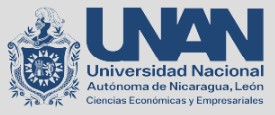Intercambio comercial entre Nicaragua y Venezuela en el período 2002-2013, con énfasis pre y post ALBA
DOI:
https://doi.org/10.5377/aes.v1i1.11437Palabras clave:
comercio internacional, dinamismo comercial, demanda recíproca, competitividadResumen
La relación real de intercambio, es decir, los beneficios del comercio exterior, dependen de la demanda de cada país por el producto del otro y solamente serán estables aquellas relaciones de intercambio en las que las exportaciones ofrecidas por cada país sean suficientes para pagar las importaciones que desea (Mill, 1840). Este estudio realiza un análisis, desde el punto de vista de la dinámica comercial, entre Nicaragua y Venezuela en el periodo 2002-2013 con énfasis en el pre y post acuerdo comercial entre ambas naciones en 2007. La teoría que sustenta esta investigación es la planteada por Mill (1840) sobre la demanda recíproca. Se describen variables de comercio exterior y se calculan índices de dinamismo. Los resultados demuestran beneficios en comercio para ambas naciones, aunque se evidencia asimetría en las relaciones comerciales. Nicaragua se sustenta en una canasta exportadora limitada de carne bovino, azúcar de caña, café y ganado bovino, y aunque es competitiva, la evidencia para el periodo estudiado demuestra que tenía ritmo decreciente. Por su parte, aproximadamente el 99% de las exportaciones de Venezuela se basaban en petróleo y sus derivados. Finalmente, aunque la teoría abordada no se evidencia en su plenitud, Venezuela representa un importante destino comercial para Nicaragua y por el tamaño de las naciones podría ser una causa de las asimetrías existentes en las capacidades comerciales. No por esto las relaciones se deben de restringir, al contrario, buscar las maneras formales para lograr la maximización y el beneficio conjunto entre ambas naciones.
Descargas
Citas
Borbón, J., Beirute, T., Briceño, J., Jácome, F., y Jaramillo , G. (2012). América Latina: Caminos de la Integración Regional.
Capelán, J. (30 de 5 de 2010). Nicaragua y el ALBA. nacional y region centroamericana, pág. (http://tortillaconsal.com/tortilla).
Carbaugh, R. (2009). Economía Internacional (Décimo Segunda ed.). (J. Reyes Martínez, Ed., P. Mascaró Sacristán, & M. E. Treviño Rosales, Trads.) Ciudad de México, Distrito Federal, México: Cengage Learning.
Hernández, D., y Chaudary, Y. (2015). La Alianza Bolivariana para los Pueblosde Nuestra América - Tratado de Comercio de los Pueblos (alba-tcp). Vigencia y viabilidad en el actual contexto venezolano y regional.
GRUN. (2012). Plan Nacional de Desarrollo Humano 2012-2016.
Krugman P. y Obstfeld, M. J. (2012). Economía Internacional: Teoría y Política. Madrid: Pearson Educación, S.A, Madrid,2012.
Lima, J. E., & Alvarez, M. (2010). Manual de comercio exterior y política comercial Nociones básicas, clasificaciones e indicadores de posición y dinamismo.
ManuelB. (28 de enero de 2011). blogspot. Obtenido de blogspot: http://relacionesnv-manuelb.blogspot.com/2011_01_01_archive.html
MIFIC. (2014). Informe de Relaciones Comerciales Nicaragua-Venezuela 2013. Managua.
Mill, J. S. (1844). Ensayos sobre algunas cuestiones disputadas en Economía Política.
Ricardo, D. (1817). Principios de economía política y tributación.
Samuelson, N. (2006). Economía 18va ed. Mexico, D. F.: McGRAW- HILL/ Interamericana editores, S.A.
Villalobos, D. (2012). La República Bolivariana de Venezuela y Nicaragua, en el marco del acuerdo energértico. CIENCIA E INTERCULTURALIDAD, 11(2).
https://doi.org/10.5377/rci.v11i2.963
WTO. (2012). Trade Policy Review Nicaragua. Technical Report, World Trade Organization.

Publicado
Cómo citar
Número
Sección
Licencia
Derechos de autor 2020 Universidad Nacional Autónoma de Nicaragua, León (UNAN León)

Esta obra está bajo una licencia internacional Creative Commons Atribución-NoComercial-CompartirIgual 4.0.













